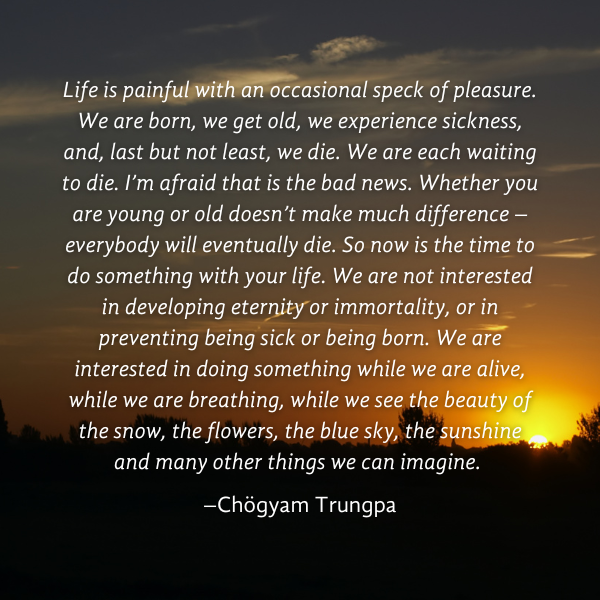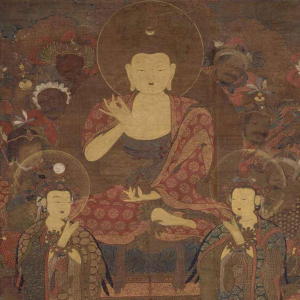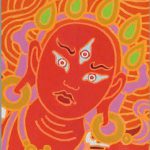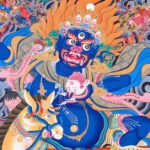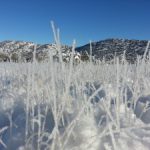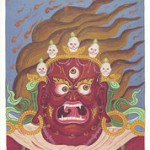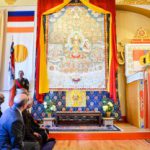Thursday
Dying & Death Classes on Shambhala Online
By Alley Smith

Death is the greatest of all teachers. –The Buddha
Shambhala Online has been offering a variety of courses on topics related to dying and death. These topics enable the sangha and outside community members to gather and think about death, engage in contemplative practices, and toil with topics such as fear, anxiety, the unknown, and how to have conversations about death.
The Shambhala community is gathering with purpose: to understand the dying process, to recognize and articulate the role of spiritual, religious and existential support, practices, and cultural norms within the modern Buddhist context. The result is tremendous openness and courage to face the inevitable and unknown in a gentle and relaxed way.
As Chögyam Trungpa Rinpoche says, Life is painful with an occasional speck of pleasure. We are born, we get old, we experience sickness, and, last but not least, we die. We are each waiting to die. I’m afraid that is the bad news. Whether you are young or old doesn’t make much difference – everybody will eventually die. So now is the time to do something with your life. We are not interested in developing eternity or immortality, or in preventing being sick or being born. We are interested in doing something while we are alive, while we are breathing, while we see the beauty of the snow, the flowers, the blue sky, the sunshine and many other things we can imagine.
While we are alive we can explore our personal belief systems about dying and death, our struggles, vulnerabilities, strong emotions, personal values, needs, and much more. Death has so much to teach us. Even as the Buddha was dying, he taught that suffering (dukkha) comes from not living in accordance with the truth of impermanence and interdependence. Death itself is a profound spiritual transmission.
Students have been gathering across the global community at Shambhala centers in Seattle, Dallas, Halifax, Los Angeles, and Philadelphia to offer support and practice advice. Communities are interested and invested in doing something while they are alive, while breathing, to be embraced by the sangha, to be met with unconditional kindness and the warmth of the Great Eastern Sun.
In the end, everything is left up to the individual. Therefore, most Buddhists do not take the truth of impermanence half-heartedly. Whether we are studying the Tibetan Book of the Dead, teachings of Amitabha Buddha, the Pure Lands, Sukhavati, Bodhichitta, the Bardos, and a vast array of teachings, we must do as many great Rinpoches and Tibetan lamas suggest. Engage in whichever practices are clearest, familiar, and most vivid on our deathbeds.
While we are alive we must be willing to face old age, sickness, and death with confidence and fearlessness. We must abandon any notion of resentment and attachment. Ask yourself, why would the Buddha say, Death is the greatest of all teachers? What can we learn from his words? In the end, as Trungpa Rinpoche says, “It’s up to you sweetheart.”
Shambhala Online would like to invite you to attend any one of these upcoming sessions in 2025:
Fear & Fearlessness: Navigating Life & Loss
March 27. During this online session, we will explore Chögyam Trungpa Rinpoche’s teachings on “Fear and Fearlessness” from the timeless classic, Shambhala: The Sacred Path of the Warrior.
The Buddha’s Discourse on Teachings to Be Given to the Sick
November 1. During this mini-retreat, we will read and explore the Buddha’s Discourse on the Teachings to Be Given to the Sick. We will examine traditional Buddhist teachings on the six senses, six sense objects, six elements, the five aggregates, and more.
Making Friends with Death & Dying: Support Group (1st Monday night of every month)
Next session April 7. Support group sessions will include a short talk, meditation practice, and an open forum to discuss personal experiences with old age, sickness, death, grief and bereavement. All are welcome. We respect your privacy. These sessions will not be recorded.
The 49 Day Ceremony: A Celebration of Life & Death
December 13. Join Chaplain Alley Smith for a 3-hour online mini-retreat as she guides participants into a deeper understanding of the 49 Day Ceremony and the common Buddhist practices and rituals that follow someone’s death – all within a modern Buddhist context.
Alley Smith (she/her) is an ordained Zen Buddhist Chaplain, scholar, researcher, and lecturer who serves at a college and university. Alley is deeply influenced by Pure Land Buddhism and Vajrayana. She has been a member of Shambhala and Zen since 1999. Alley works in the funeral industry in Vermont. She teaches a number of courses on Shambhala Online.
Entries filed under Dharma Teachings
The Gift of Fear – HIGHLIGHT
An excerpt from “Natural Bravery: Fear and Fearlessness as a Direct Path of Awakening” by Gaylon Ferguson The starting point on the path of fearlessness is the discovery of fear. — Chögyam Trungpa, “Conquering Fear.” Our habitual response to fear is to move away from this uncomfortable feeling. We recoil ... continuePosted June 4, 2017 by CGH
Humanity, Chaos, and Wisdom – HIGHLIGHT
Reflections on favorite passages from a book by Sakyong Mipham Rinpoche by Susan Firer I’ve been re-reading the book, The Shambhala Principle, written by my teacher Sakyong Mipham, who is the head of Shambhala. I would like to share a few passages that I try to keep in ... continuePosted May 5, 2017 by CGH
A Quality of Healing – HIGHLIGHT
Basic goodness and the path of relationships by Shastri Nick Kranz There are many ways to think about basic goodness. Sometimes it’s referred to as basic healthiness. When we touch into this inherent okay-ness we gain access, I believe, to a quality of healing that is much needed ... continuePosted April 29, 2017 by CGH
Aging in the Buddhadharma 2 – HIGHLIGHT
Part Two of an interview on aging and meditative practice, with Acharya Han de Wit by Adrienne Chang AC: What role does your practice and the Buddhadharma have in aging—how do they help the adjustment process? HW: Being aware. Practice helps in that sense. Practice helps you have a ... continuePosted April 21, 2017 by CGH
Aging in the Buddhadharma 1 – HIGHLIGHT
Part One of an interview with Acharya Han de Wit by Adrienne Chang Acharya Han de Wit was an early founder of the European Shambhala sangha and close student of the Vidyadhara. In addition to his decades of teaching and work within the Shambhala sangha, Acharya de Wit is ... continuePosted April 19, 2017 by CGH
Comprender la estación de döns
por Russell Rodgers Hay un período antes del año nuevo tibetano a finales del invierno y principios de la primavera, según la tradición budista tibetana, en el que fructifica el karma acumulado y surgen los obstáculos sociales. Este año haremos la Práctica de las mamos entre el ... continuePosted February 2, 2017 by luz_rodriguez
Understanding Dön Season – HIGHLIGHT
When the world is filled with evil, pacify the Döns and Mamos by Russell Rodgers In the Tibetan Buddhist tradition, there is a period before the Tibetan New Year in the late winter/early spring when accumulated karma comes to fruition and societal obstacles arise. This year, between February ... continuePosted February 1, 2017 by CGH
Ekajati and the Ati Teachings – HIGHLIGHT
Exploring depth and meaning in the Ekajati protector chant by Russell Rodgers Ekajati: Queen of the Mamos, thangka painting by Chogyam Trungpa Rinpoche This chant has an extraordinary level of teaching in it about the nature of mind and the nature of reality. To the extent that one truly ... continuePosted January 2, 2017 by CGH
Por qué, cuándo y cómo se ofrece generosidad
por Walker Blaine, Maestro de liturgia de Sákyong Mipham Rimpoché y Heraldo de la corte Kalapa Si la gente entendiera los beneficios personales de la generosidad, no sería capaz de contener la alegría de ver ocasiones para dar. Los santos y los sabios de todas las ... continuePosted January 2, 2017 by luz_rodriguez
Is Vetali Real? – HIGHLIGHT
Our series of essays on the Shambhala chants continues, with a look at the “reality” of another protector by Russell Rodgers “Is Vetali real” seems like a simple enough question, deserving a “yes” or “no” answer. In fact, this question has many levels. In one of the previous ... continuePosted December 31, 2016 by CGH
Entender la “Proclamación de la bondad”
Foto de Susanne Long Keniley, Centro Shambhala de Albuquerque Esta simple súplica de cuatro líneas compuesta por Sákyong Mipham Rimpoché tiene muchísimo contenido. Uno de sus significados está al nivel de los pensamientos y asociaciones ordinarias. Luego hay otro nivel que las palabras no pueden expresar directamente ... continuePosted November 6, 2016 by luz_rodriguez
Meet the Four Armed Mahakala – HIGHLIGHT
What is a mahakala? Do they exist in reality? by Russell Rodgers These are questions provoked by doing the chants. In this essay, I’ll explore those questions a little more, and in addition talk about the Four Armed Mahakala in particular. In the previous essay, “The Protector Ritual,” we ... continuePosted October 27, 2016 by CGH
Aspiración de Shambhala
por Russell Rodgers En medio de nuestra corriente de pensamientos habituales, tendemos a olvidar lo que nos es más importante. Los cantos de aspiración son recordatorios. Si aspiramos conscientemente a algo, es más probable que ocurra. Si no aspiramos, la probabilidad es puramente aleatoria. Aun peor, el ... continuePosted October 24, 2016 by luz_rodriguez
Súplica al linaje Shambhala
por Russell Rodgers En este canto Sákyong Mipham Rimpoché reconoce las fuentes del Linaje de Shambhala. Había cuatro linajes principales en el Tíbet: los gelugpa (el linaje del Dalai Lama), los sakya, los kagyü y los ñingma. Considerando nuestro “Linaje Shambhala”, en el momento en que se ... continuePosted October 24, 2016 by luz_rodriguez
Canto de los protectores de Shambhala
por Russell Rodgers Un flujo constante de coincidencia conforma nuestras vidas. Nos levantamos por la mañana. Está lloviendo y eso siempre nos deprime un poquito. Hay un colapso de tráfico en el camino al trabajo. En el trabajo pierdes a un cliente importante. Luego sale el sol, ... continuePosted October 24, 2016 by luz_rodriguez
![]() RSS feed for the Dharma Teachings category
RSS feed for the Dharma Teachings category
View all posts from authors in Dharma Teachings: jillian_johnson

